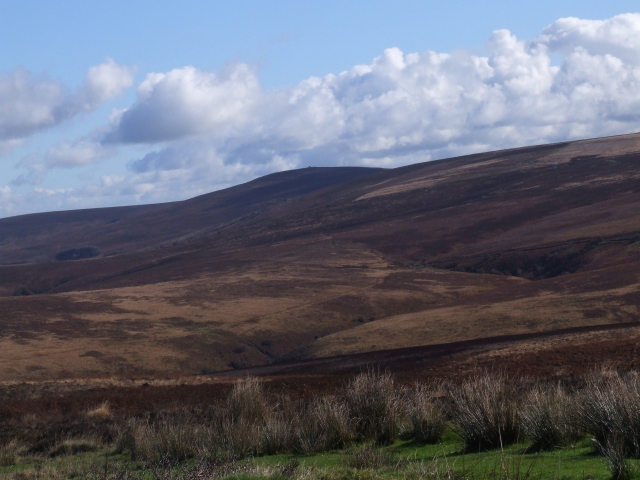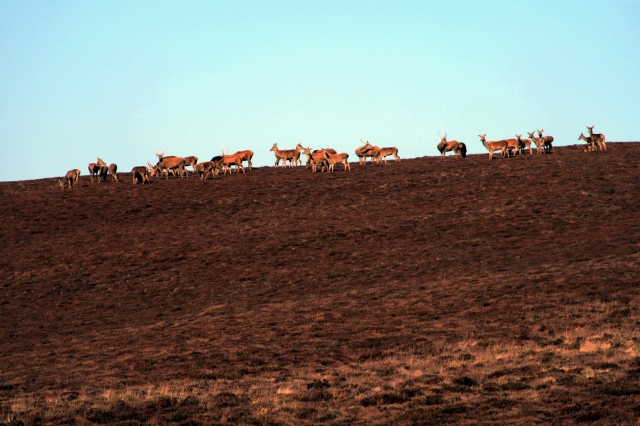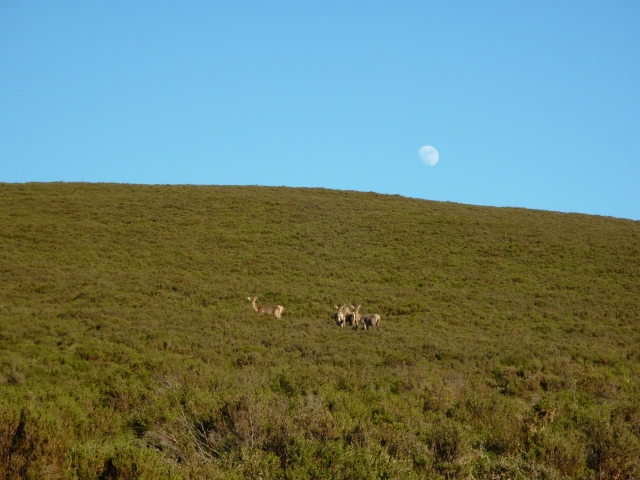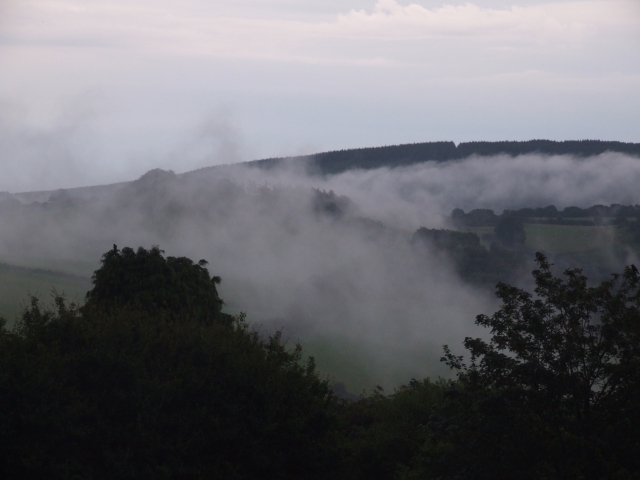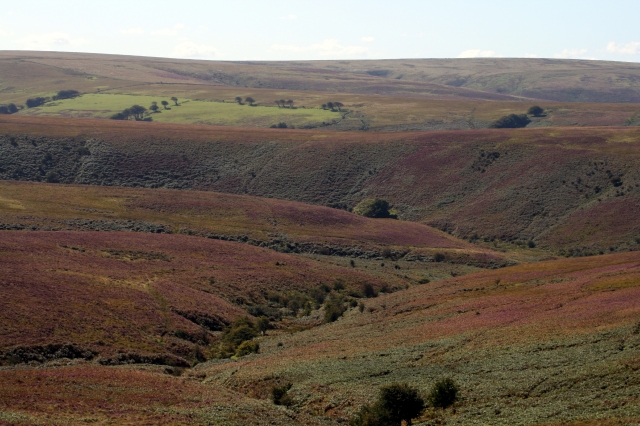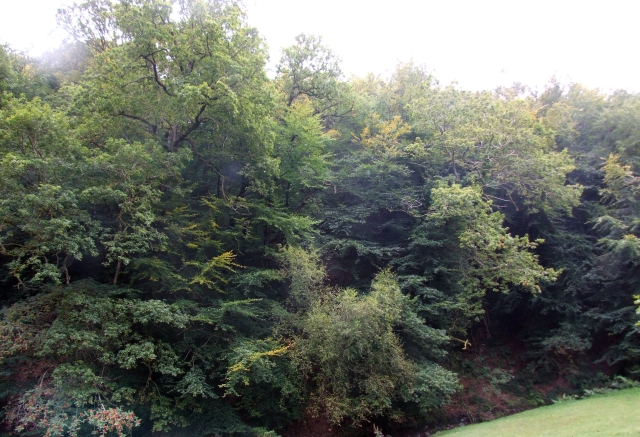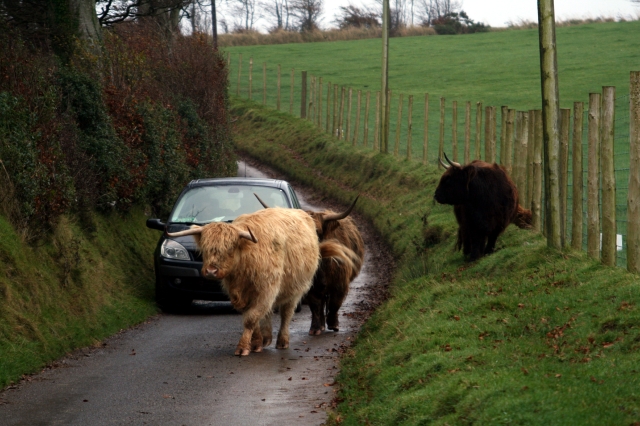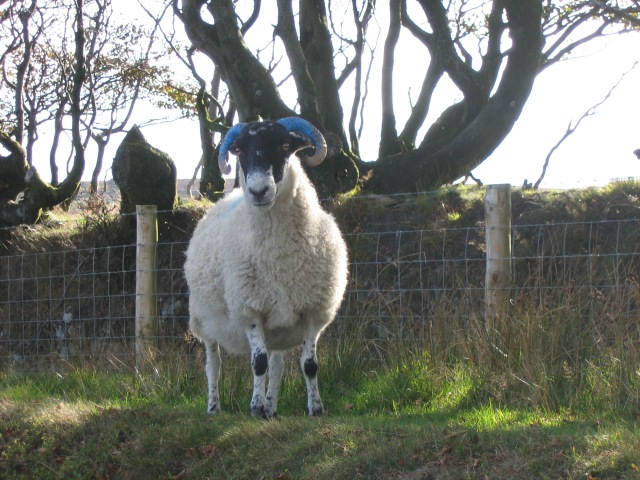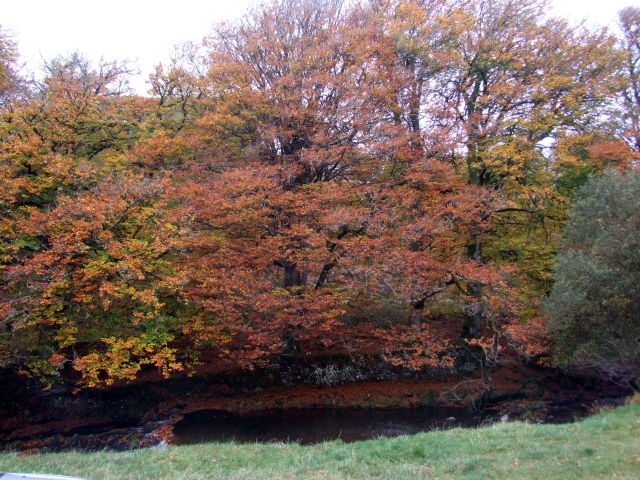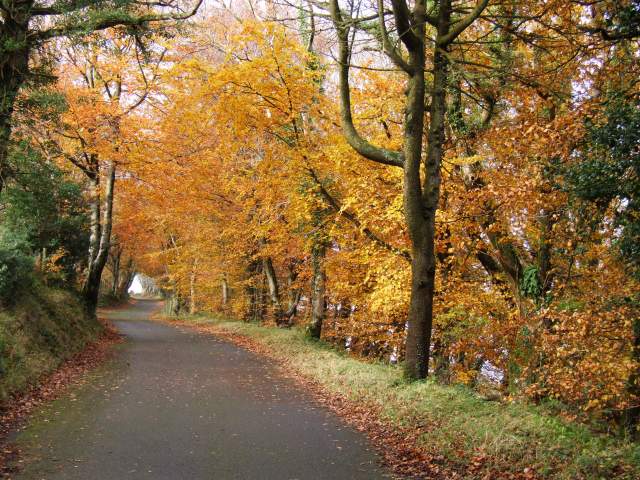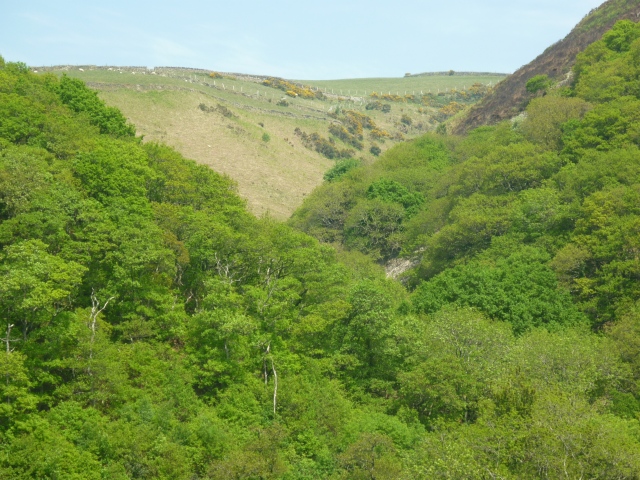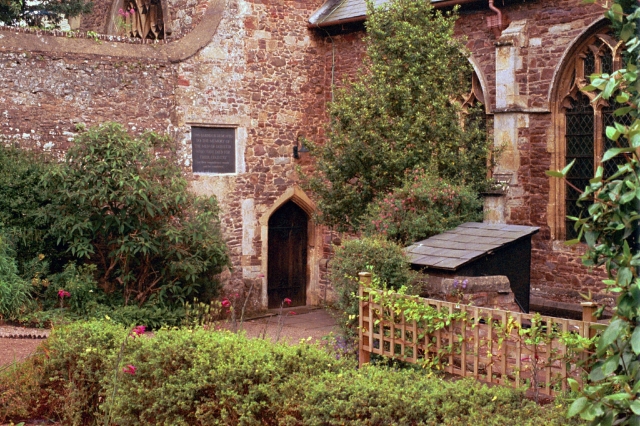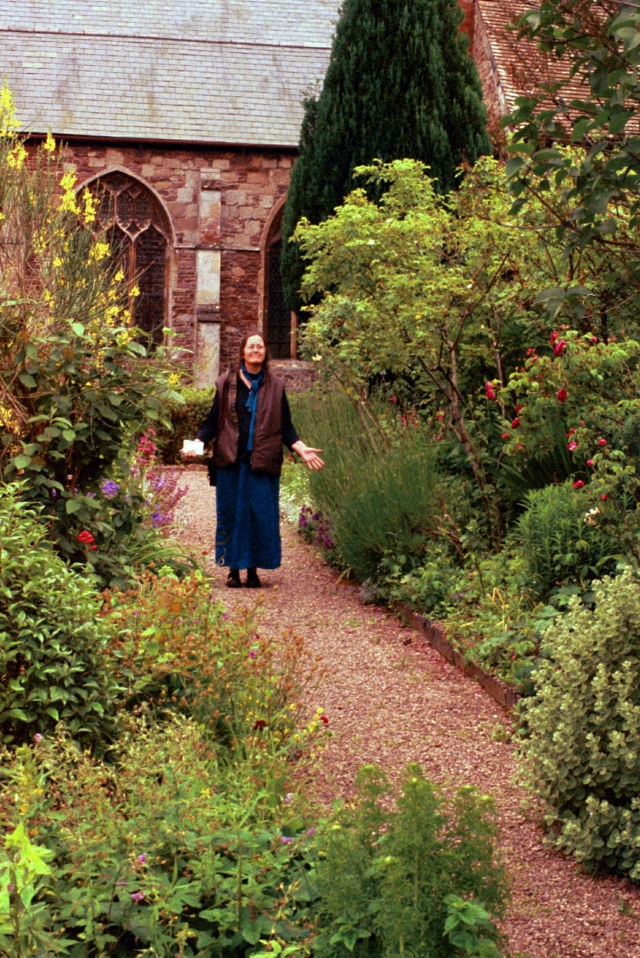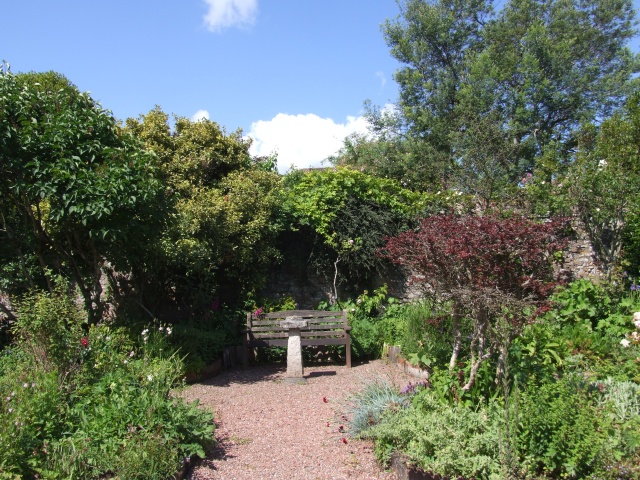There are three Exmoor books: this one, Memories of the Storm and The Summer House. True the Prodigal Wife could be said to be an Exmoor book but really it isn’t – the time spent away from the south is on the Quantock Hills which are to the east of the moor.
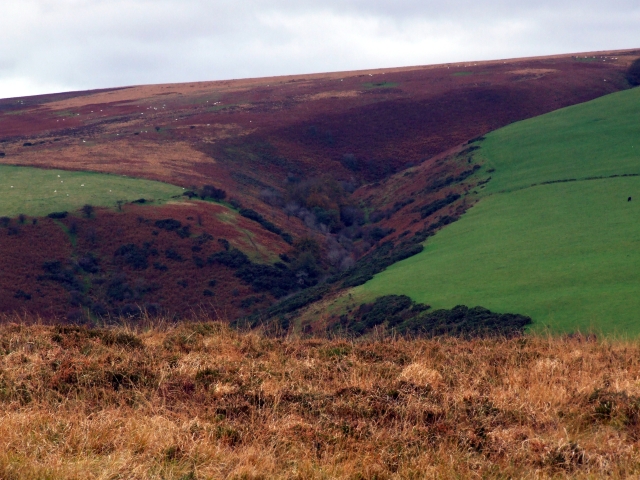
This is very Exmoor with the bracken alight in the the evening sun. Open moor (where I am standing), pasture and a deep cleeve giving great contrasts.
Exmoor is quite small and after a good deal of thought I have decided that we will look at rural Exmoor here and then the towns: Dulverton and Exford when we look at Memories; Dunster and Porlock when we get to the Summer House. It won’t be quite as well defined as that: Memories is full of the sound of water and that cannot be ignored. Still, as a plan of campaign I think this will do.
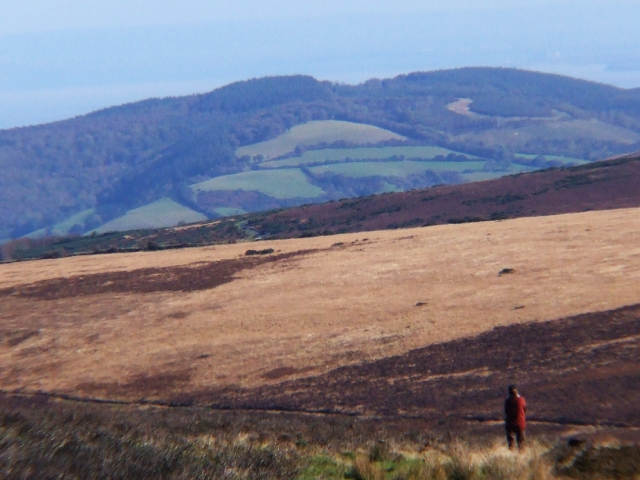
Exmoor may be a small moor but it doesn’t feel that when you are the tops. Marcia is almost lost in the foreground.
Exmoor may be the smallest of the South West moors but it is almost certainly the most dramatic and the most beautiful. It was not always the way it is now and the history is fascinating. It is worth noting that Exmoor was covered by the southern-most edge of the ice shield which did not reach as far as the other two. The erosion caused by the ice has quite a bit to do with the way things are today. After the ice retreated, there was a period when the climate was much warmer than it is today. Thus (and this is also true of Dartmoor) areas that are of no great agricultural use today were then under cultivation.
Meanwhile much of the moor was a Royal Hunting Forest while the commons outside the forest boundaries were used by the villagers to provide fuel (peat as well as wood) and as summer grazing for sheep and cattle but in the winter the only animals hardy enough to cope were the tough Exmoor ponies. Even the red deer (Cervus elephus) who have lived in this area since prehistoric days would seek shelter in the wooded valleys during the winter.
Then the country ran out of food. Or, at least, looked as though it would run out of food. Things were made worse as we were fighting Napoleon at the time and many men had been taken from the land to service in either the navy or the army. In 1818 (after the war had finished) it was decided to sell the hunting forest and turn it into productive agricultural land. The buyer (this sounds so incredible) was an iron master from Wolverley in Worcestershire. He bought 10,262 acres of hunting forest and Simonsbath Farm of 108 acres – all for the sum of £50,122. This purchase was to make a huge difference to Exmoor. Incidentally before we move on: the “Sim” in Simonsbath is pronounced “Sim” to rhyme with Tim and not “Sime” to rhyme as Time. Just thought you might like to know.
To be fair, John Knight was more than an iron master. He was already a landowner with interests in agriculture. Indeed he financed his Exmoor project by selling off his Lee Castle Estate just outside Wolverhampton. Nor was he happy with what he had bought: he went on to acquire over 16,000 acres of moorland and the manor of Brendon to the north-west.
Job one (actually carried out by Irish labourers) was to build a thirty-mile long wall around the estate. At the same time, the first of the actions that were definitely for the public good was undertaken. He turned some twenty-two miles of ancient track into proper roads thus opening up the centre of the moor for the first time.
Knight’s vision was an area where on the uplands large herds of cattle and flocks of sheep would be grazed while the more fertile lowland areas would be cultivated. He spent large sums on stripping off the turf, liming and deep ploughing the land with oxen but most of this was wasted – the climate on the moor was just not suited to corn production. It was assumed that the best cattle for here would be highland cattle and Knight bought seven hundred. All went well for about twenty years (although food shortages in the winter were a constant problem) and they tended to fetch premium prices in the local markets. However, the herd became wilder and wilder and in the end was totally unmanageable. It had to go. Experiments with two hundred Herefords were not a great success and so Devon Reds and Shorthorn were introduced. It wasn’t quite what Knight wanted but he now had a steady income from his cattle.
Sheep proved to be difficult too. The local Exmoor sheep which thrived on the moor produced only very coarse wool that fetched very little at sales. Experiments with other breeds proved costly – probably because Knight found it extremely difficult to find good shepherds but there was another problem too. Now that nobody was enforcing the old hunting forest laws, deer were being poached in large numbers and poachers saw no reason to ignore any sheep they might come across and losses due to theft rose to a level where they were quite serious.
All this was to change in 1841 when John Knight decided to retire and took himself off to Rome after handing the rein over to his brilliant son, Frederick. He was a man of immense energy and talent: he kept both ends of the his business empire together and was, in addition, the Member of Parliament for West Worcester for no less than forty-three years, raised a regiment (the First Battalion of the Worcester Rifle Volunteers) in 1859, was a Justice of the Peace and the Deputy Lieutenant for Worcester.
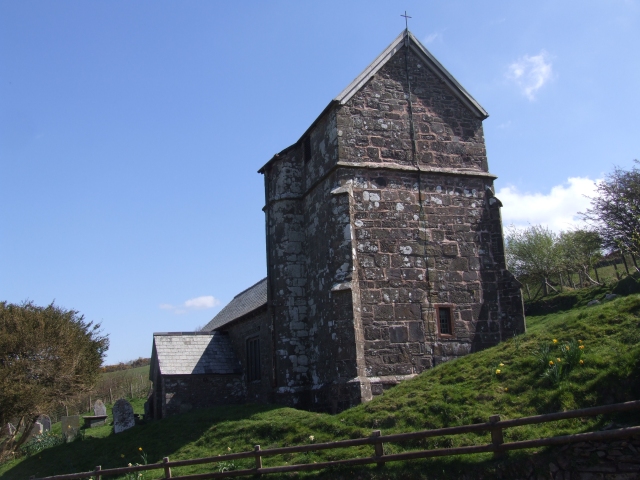
The lovely little church at Stoke Pero which dates from the 13th century but was built on the foundations of an earlier chapel. It was rebuilt in 1897 and all the materials required for the roof were brought up from Porlock Weir in pannier bags by a donkey called ‘Zulu’ who made the journey twice a day for many months.
Meanwhile he was to build about fifteen farmhouses and split the moor into separate farms in which he installed tenants, a move which enabled him to have an assured income in the form of rents.
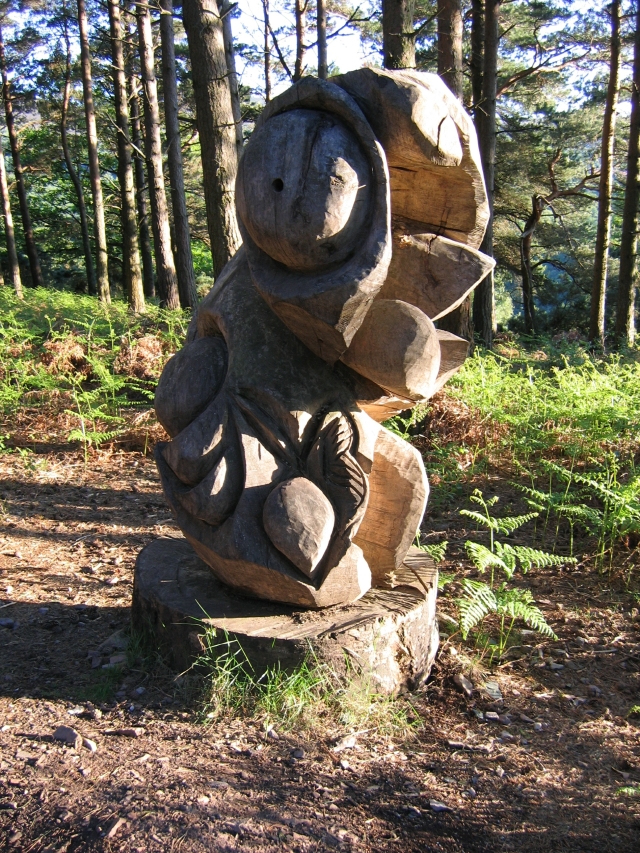
Sculpture in the wood at Webbers Cross. There are about a dozen items and as time goes on they are beginning to deteriorate. Very sad but inevitable.
And then something happened that nobody has been able to explain. Knight arranged for his labourers to create a pond (covering about 3 acres) on the top of the moors. This was done by damming the River Barle and became known as Pinkery Pond from which a leat was dug towards the east. The odd thing is that nobody knows why he did this. The usual suggestion is to provide a reserve of water for the stock but others believe it was to power a water mill that was never built.
Two matters were of great interest to both father and son: mining and the planting of beech trees. The first was a failure which made almost no impact on the moor but the latter changed the moor out of all recognition – and change that nearly everyone would agree was for the better. Nobody has any idea how many thousands of beech saplings were planted but thanks to them we now have many miles of glorious beech hedges as well as many hundreds of full grown trees. It is believed that before man started to interfere on the moor it was covered by woodland. Many of the trees that are there could well have be a thousand years old – including an old yew in the churchyard of St Dubritious in Porlock which is said to have been there when William the Conqueror first created a royal hunting forest here.
Various groups have been listing ‘ancient trees’ on Exmoor: the list is now just over 1,700 and still rising. Many if these old oaks would have been used to produce tanbark and charcoal. For example, up until about a hundred years ago the woods at Hawkcombe near Porlock was a hive of activity with groups of men working on coppicing stools and others burning charcoal. Meanwhile, of course, there were dozens of carts carrying the wood’s product to the customers. Today, Hawkcombe Wood is a National Nature Reserve and a Site of Special Scientific Interest.
All of which is great because the main industry on Exmoor today is, of course, tourism and the fantastic scenery as it now is (because none of it is ‘natural’) is one of its major attractions.
We now need a quick trip into Dunster because the Memorial gardens there play a vital part in this book. Situated behind the church and linked by a door (see top photo), it is a place of great tranquility where Marcia found unexpected inspiration. there was one special moment when she realised that Felix would meet Lizzie at this bench (bottom photo) when he was sitting on this bench.
For some notes and photographs describing The Birdcage country the link is TB Country

